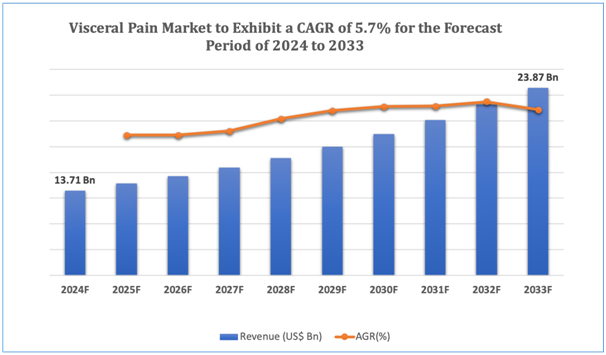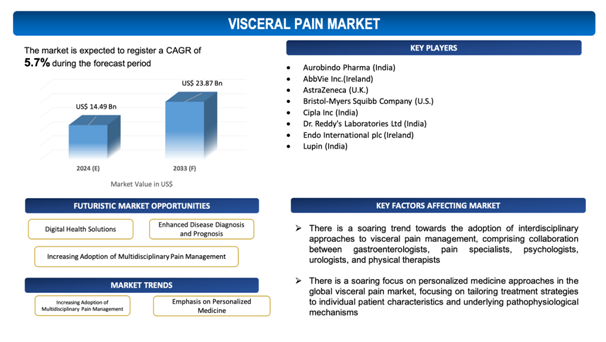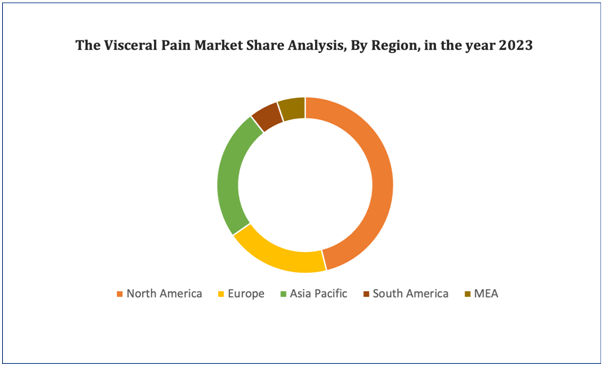Visceral Pain Market Overview
The global Visceral Pain market is estimated to be worth over USD 23.87 Bn in 2033 and is expected to grow at CAGR of5.7% during the forecast period (2024-2033).
Visceral pain, a complicated and oftentimesexhaustingkind of pain arising from internal organs such as the stomach,intestines, or bladder, presentssubstantial challenges to patients and healthcare providers across the globe. Contrary to the somatic pain, which originates from the muscles, skin, or joints, visceral pain is badly localized and marked by dull,deep, or cramping sensations. This subtle nature makes visceral pain difficult to diagnose and manage effectively, paving its way to long-drawn-out suffering and lessened quality of life for affected individuals.
The global market for visceral pain management surrounds a comprehensivescale of treatment modalities, comprisingphysical therapy, pharmacological interventions, psychological interventions, and interventional procedures. Pharmacological alternativesare likely tocomprise nonsteroidal anti-inflammatory drugs (NSAIDs), antispasmodics, opioids, antidepressants, and anticonvulsants, personalized to tackleparticular underlying mechanisms contributing to visceral pain. In addition, interventional procedures such as nerve blocks, neurostimulation, and neuro-ablation techniques are likely to be employed to target pain signals at the source.
However, challenges such as restricted understanding of visceral pain mechanisms, variability in patient responses to treatment, and the risk of medication adverse effects highlight the need for further research and innovation in this domain. Emerging technologies such as targeted drug delivery systems, neuromodulation devices, and innovative imaging techniques hold commitment for enhancing the diagnosis and management of visceral pain. Along with that, the integration of multidisciplinary approaches, involving comprehensive pain management programs and patient-centered care models, is critical to address the intricate biopsychosocial factors contributing to visceral pain.
Notwithstanding with the existing restraints, the soaring recognition of visceral pain as a substantial healthcare burden and the growingfocus on personalized medicine and precision pain management provide opportunities for innovation and advancement in the global visceral pain market. By leveraging interdisciplinary collaboration, technological advancements, and evidence-based practices, healthcare providers can strive to enhance outcomes and improve the quality of life for individuals living with visceral pain across the globe.
Figure 1. Visceral Pain: Market Size

Get more details on this report - Request Free Sample
Key Market Insights &Current Market Landscape:
Visceral pain, initiating from internal organs such as the intestines or bladder, presents as substantial challenges in diagnosis and management, fueling demand for effective treatment solutions. The market landscape surrounds a scale of pharmacological and non-pharmacological interventions, comprising antidepressants, opioids, psychological, and neurostimulationtherapies. Significant developments in the market comprise the advent of novel technologies emphasized at enhancing the understanding and management of visceral pain. Neuromodulation devices, such as spinal cord stimulators and peripheral nerve stimulators, provide targeted relief by controlling pain signals at the neural level. In addition to that, progressions in targeted drug delivery systems allow precise administration of analgesic medications to affected areas, mitigating systemic adverse effects. Along with that, there is a soaring focus on multidisciplinary approaches to visceral pain management, consolidating pharmacological treatments with physical therapy, cognitive-behavioral interventions, and lifestyle modifications. These holistic approaches address the multifarious nature of visceral pain, focusingat improving patient outcomes and quality of life. Regardless of these advancements, challenges such as limited understanding of visceral pain mechanisms, variability in patient responses to treatment, and the necessity for personalized approaches continues. However, continuing research and innovation in the domain hold commitment for addressing these challenges and fuelingsustained growth in the global visceral pain market.
Market Dynamics
Market Drivers
Soaring Prevalence of Visceral Pain Conditions
The increasing prevalence of visceral pain conditions presents as a major market driver for the global visceral pain market, spurring demand for efficient treatments and management strategies. Visceral pain surrounds a comprehensivescale of conditions affecting internal organs such as the urinary system, gastrointestinal tract, and reproductive organs. Conditions such as irritable bowel syndrome (IBS), endometriosis, interstitial cystitis,and chronic pancreatitis are among the most prevalent causes of visceral pain, affecting millions of individuals across the world.
Factors contributing to the growing prevalence of visceral pain conditions comprisesvariations in dietary patterns, lifestyle habits, and environmental factors, as well as geriatric populations and the surge in the incidence of chronic diseases such as diabetes and obesity. In addition to that, enhanced diagnostic techniques and escalated awareness among healthcare providers have paved its way to more precise and timely identification of visceral pain disorders. For that reason, there is an increasing recognition of the strain of visceral pain on individuals' quality of life and healthcare systems, accelerating demand for advanced treatments and management approaches. Pharmaceutical interventions, including analgesic medications, neuromodulators, and antidepressants, are commonly used to alleviate visceral pain symptoms.
Other than that, non-pharmacological approaches such as cognitive-behavioral therapy, physical therapy, and dietary modifications hold an essential role in comprehensive pain management. The soaring prevalence of visceral pain conditions underlines the need for continued research and investment in the development of novel therapies and technologies to tackle this increasing healthcare burden. By addressing the unmet needs of patients with visceral pain and enhancing treatment outcomes, the global visceral pain market stands ready for robust growth in the forthcoming years.
Market Restraints
With regard to numerous advantages of Visceral Pain, the market faces several challenges due to the unique characteristics and requirements associated with them. Some of the key market challenges include:
- Limited Understanding of Visceral Pain Mechanisms:The intricate nature of visceral pain mechanisms presents a substantial restraint on the global visceral pain market. Contrary to the somatic pain, which is under control, visceral pain includescomplex neural pathways and visceral-somatic interactions that are still not fully interpreted.This limited understanding hinders the development of targeted therapies and personalized treatment approaches, paving its way to challenges in effectively administering visceral pain conditions and achieving optimal patient outcomes.
- Variability in Patient Responses to Treatment:The disparate nature of visceral pain conditions leads to variability in patient responses to treatment, representing a notable challenge for the global visceral pain market.Individuals are likely to showcasevariedsymptom profiles, treatment preferences, and underlying pathophysiological mechanisms, leading to unpredictability in therapeutic outcomes.This variability entangles the selection of appropriate treatment strategies and are likely to necessitate a trial-and-error approach, resulting in suboptimal pain relief and patient dissatisfaction.
Market Opportunities
Digital Health Solutions
Digital health solutions represent a pressing market opportunity for the global visceral pain market, providingadvanced approaches to enhance patient care, improve treatment outcomes, and maximize management strategies. These solutions surround a variedscale of technologies and platforms, comprising wearable devices, mobile applications, telemedicine platforms, and remote monitoring tools, which can be facilitate to tackle the multifarious nature of visceral pain conditions. Digital health solutions allow patients to track symptoms, monitor medication adherence, and access educational resources, authorizing them to take an active role in administering their pain and enhancing their quality of life. Along with that, telemedicine platforms support remote consultations with healthcare providers, overcoming geographical barriers and improving access to specialized care for individuals with visceral pain. Healthcare providers can utilize digital health solutions to remotely monitor patients' progress, adjust treatment plans, and offer timely interventions, which leads to more personalized and responsive care. In addition to that, digital health technologies allow the collection and assessment of real-time data, supporting research initiatives and the development of novel therapies for visceral pain. By union of digital health solutions into clinical practice, the global visceral pain market can capitalize on the opportunities to improve patient engagement, enhance treatment outcomes, and fuel innovation in pain management strategies.
Market Trends
- Increasing Adoption of Multidisciplinary Pain Management:There is a soaring trend towards the adoption of interdisciplinary approaches to visceral pain management, comprising collaboration between gastroenterologists, pain specialists, psychologists, urologists, and physical therapists.This trend determines the intricate biopsychosocial nature of visceral pain conditions and focused on comprehensive treatment strategies that tackle both physical and psychological aspects of pain.By incorporatingpsychological, pharmacological, and physical therapies, multidisciplinary pain management focuseson improving treatment outcomes, improve patient satisfaction, and mitigate healthcare utilization in the global visceral pain market.
- Emphasis on Personalized Medicine:There is a soaring focus on personalized medicine approaches in the global visceral pain market, focusingon tailoring treatment strategies to individual patient characteristics and underlying pathophysiological mechanisms.This trend recognizes the diversity of visceral pain conditions and the changes in patient responses to treatment, underscoring the prominence of personalized approaches to maximize outcomes.Progresses in genetic testing, biomarker identification, and predictive modellingallow clinicians to stratify patients based on their risk profiles and treatment responses, steering the selection of targeted therapies and optimizing pain management strategies.

Get more details on this report - Request Free Sample
Visceral Pain Market: Key Segments
By Drug Class
- Calcium Channel Blockers
- Nonsteroidal Anti-Inflammatory (NSAID)
- Others
By Indications
- Interstitial Cystitis
- Crohn’s
- Irritable Bowel
- Chronic Prostatitis
- Others
By End Users
- Hospitals
- Homecare
- Specialty Clinics
- Others
By Distribution Channel
- Hospital Pharmacy
- Online Pharmacy
- Retail Pharmacy
By Key Geographical Regions
- North America
- Europe
- Asia-Pacific
- Middle East and Africa
- South America
Visceral Pain Market: Regional Analysis
North America is expected to dominate the market due to large number of patients diagnosed with heart diseases and high R&D and healthcare expenditure. Asia-Pacific is expected to witness the highest growth for global visceral pain market in the forecasted period due to rising cardiac surgeries & the continuous rise in patients with cardiovascular diseases and rapidly improving health care infrastructure in the region.
Figure 4. Visceral Pain Market: Distribution by Region

Get more details on this report - Request Free Sample
Leading Visceral Pain Developers
Industry Trends and Global Forecasts, 2023-2035 report features an extensive study of the current market landscape, market size and future opportunities associated with the Visceral Painmarket, during the given forecast period. Further, the market report highlights the efforts of several stakeholders engaged in this rapidly emerging segment of the biopharmaceutical industry. Key takeaways of the Visceral Painmarket are briefly discussed below.
The report includes the list of players operating in the global Visceral Painmarket. Some of the key players include:
- Aurobindo Pharma (India)
- AbbVie Inc.(Ireland)
- AstraZeneca (U.K.)
- Bristol-Myers Squibb Company (U.S.)
- Cipla Inc (India)
- Dr. Reddy's Laboratories Ltd (India)
- Endo International plc (Ireland)
- Lupin (India)
- Mylan N.V. (U.S.)
- Novartis AG (Switzerland)
- Pfizer Inc (U.S.)
- Sun Pharmaceutical Industries Ltd (India)
- Teva Pharmaceutical Industries Ltd (Israel)
Recent Developments in the Visceral PainMarket
Several recent developments have taken place in the field of Visceral Pain, some of which have been outlined below. These developments, even if they took place post the release of our market report, substantiate the overall market trends that we’ve outlined in our analysis chronologically.
- In January 2019, Ironwood Pharmaceuticals Inc. declared the approval of ‘LINZESS’ with a strength of 72 mcg, 145 mcg, and 290 mcg in China for the treatment of irritable bowel syndrome (IBS) along with constipation in adults.
Scope of the Report
The market report presents an in-depth analysis of the various firms / organizations that are engaged in this market, across different segments, as defined in the below table:
|
Key Report Attributes |
Details |
|
Base Year |
2023 |
|
Forecast Period |
2024-2033 |
|
CAGR (2024-2033) |
5.7% |
|
Drug Class |
|
|
Indications |
|
|
End Users |
|
|
Distribution Channel |
|
|
Key Geographical Regions |
|
|
Key Companies Profiled |
|
